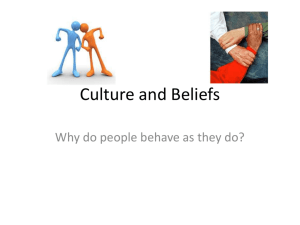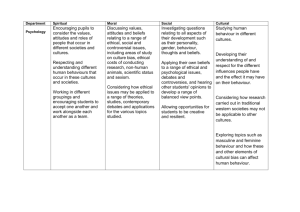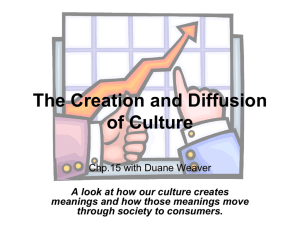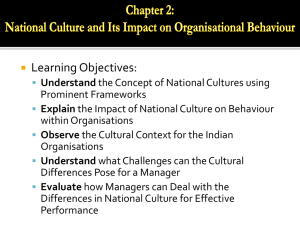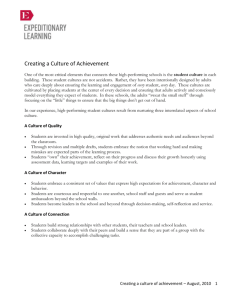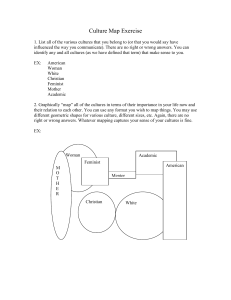Presentation1 Cultural awareness
advertisement
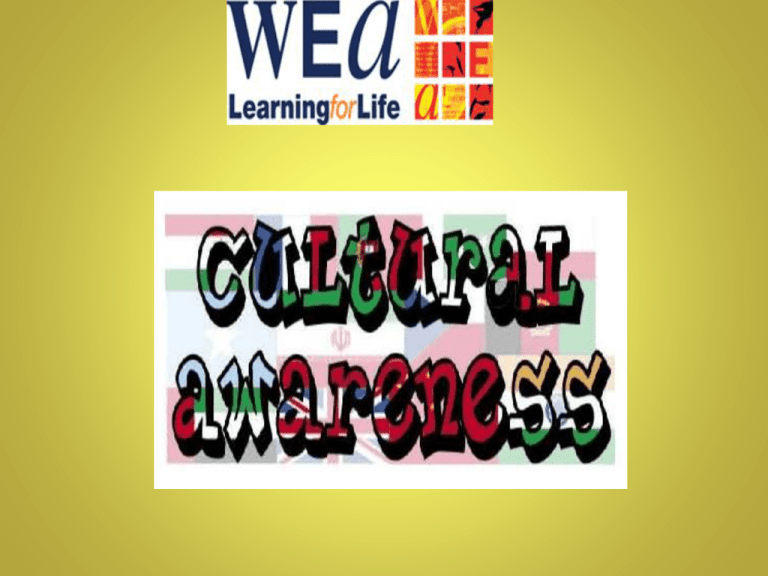
What does culture awareness mean to you? Someone's cultural awareness is their understanding of the differences between themselves and people from other countries or other backgrounds, especially differences in attitudes and values. Degrees of Cultural Awareness There are several levels of cultural awareness that reflect how people grow to perceive cultural differences. My way is the only way - At the first level, people are aware of their way of doing things, and their way is the only way. At this stage, they ignore the impact of cultural differences. I know their way, but my way is better - At the second level, people are aware of other ways of doing things, but still consider their way as the best one. In this stage, cultural differences are perceived as source of problems and people tend to ignore them or reduce their significance. My Way and Their Way - At this level people are aware of their own way of doing things and others’ ways of doing things, and they choose the best way according to the situation. At this stage people realise that cultural differences can lead both to problems and benefits and are willing to use cultural diversity to create new solutions and alternatives. Our Way - This fourth and final stage brings people from different cultural background together for the creation of a culture of shared meanings. People dialogue repeatedly with others, create new meanings, new rules to meet the needs of a particular situation. Group Activity write down, what you have ever heard about other cultures, positive and negative, Key Considerations •Be aware of your own cultural influences. •Be aware of judging other people's behaviour and beliefs according to the standards of your own culture. •Be aware of making assumptions about cultural influences and applying generalisations to individuals. •Understand that the behaviour and beliefs of people within each culture can vary considerably. •Understand that the extent to which people adopt practices of their new country and retain those from their cultural background can vary within communities, even within families. •Understand that not all people identify with their cultural or religious background. •Understand that culture itself is a fluid entity, undergoing transformations as a result of globalisation, migration and the diaspora influence. •Increase your knowledge about different cultural practices and issues through cultural background information sessions and/or resources and cultural awareness training. “A fish only discovers its need for water when it is no longer in it. Our own culture is like water for the fish. It sustains us. We live and breathe through it.” by Stephanie Quappe and Giovanna Cantatore Learners are worried to come into class due to their ethnic identity. Community Leader: “They should have someone who understands the way learners from other cultures are, someone that they can talk to, that won’t be prejudiced about other cultures.” How do we manage cultural diversity? Think of ways of embedding the culture into your work and not viewing it as an add-on We are generally aware that the first step in managing diversity is to recognise it and not to fear it. Admit that you don’t know. Knowing that we don’t know everything, that a situation does not make sense, that our assumptions may be wrong is part of the process of becoming culturally aware. Assume differences, not similarities. Suspend judgments. Collect as much information as possible so you can describe the situation accurately before judging it. Empathy. In order to understand another person, we need to try standing in their shoes. Through empathy we learn of how other people would like to be treated by us. Systematically check your assumptions. Ask your colleagues for feedback and constantly check your assumptions to make sure that you clearly understand the situation. Become comfortable with ambiguity. The more complicated and uncertain life is, the more we tend to seek control. Assume that other people are as resourceful as we are and that their way will add to what we know. Group Activity Benefits • Greater cultural awareness and consideration, by everyone involved in the strategic planning and practical delivery of all services, provides a better experience for existing users and encourages others to participate therefore has a key role to play in achieving genuine equality of opportunity for other cultures. • The awareness of cultural difference is vital for success. Cultural Competence helps you to understand how and why people think the way they do. • Cultural Awareness is the foundation of communication and it involves the ability of standing back from ourselves and becoming aware of our cultural values, beliefs and perceptions. Why do we do things in that way? How do we see the world? Why do we react in that particular way? • Cultural awareness becomes central when we have to interact with people from other cultures. People see, interpret and evaluate things in a different ways. What is considered an appropriate behaviour in one culture is frequently inappropriate in another one. Build your cultural knowledge: Try and learn a bit more about other cultures and countries. Information is easily found on the internet and in books. You can also ask your colleagues. Start to build some sort of cultural awareness. Treat people as individuals: Information in other cultures is usually based on generalisations. This means that the information will not apply to every single member of that culture. Be aware of this and try and deal with people as individuals. Remember: Cultural awareness is the ability to look outside of ourselves and be aware of the cultural values, and customs of the culture we are in. What may be normal and acceptable to us, may be unusual or unacceptable in another culture.


